SPINONE
(Spinone Italiano)
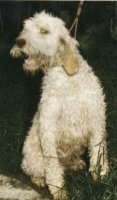
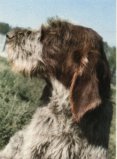
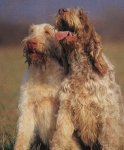
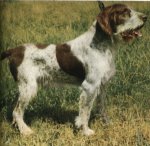
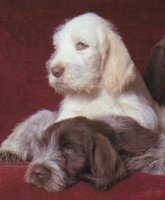
FCI-Standard N° 165 / 04. 12. 1998 / GB
TRANSLATION : Mrs. Peggy Davis.
ORIGIN : Italy.
DATE OF PUBLICATION OF THE ORIGINAL VALID STANDARD : 03.04.1992.
UTILIZATION : Pointing dog.
CLASSIFICATION F.C.I. :Group 7 Pointing Dogs.
Section 1.3 Continental Pointing Dogs, « Griffon type ».
With working trial.
SUGGESTED BREEDINGS by MENANDPETS.COM:
No breeding to signal
if you want to know like signaling yours, contacts: marketing@inseparabile.it
BRIEF HISTORICAL SUMMARY : We find in the bibliography descriptions which evoke a rough-haired dog of Italian origin which passes as being the ancestor of the present Spinone. In his book « Le parfait chasseur » (The perfect Hunter), Sélincourt, in 1683, speaks of a « griffon » coming from Italy and the Piedmont. In the Middle Ages this dog has often been represented by famous painters; the best known painting is a fresco by Andrea Mantegna in the ducal palace of Mantua, from the 15th century.
GENERAL APPEARANCE : Dog of solid construction, robust and vigorous; powerful bone; well developed muscles, hair rough.
IMPORTANT PROPORTIONS : His build tends to fit into a square. The length of the body is equal to the height at the withers, with a tolerance of 1 to 2 cm longer. The length of the head is equal to 4/10ths of the height at the withers. Its width, measured at level of the zygomatic arches, is inferior to half its length.
BEHAVIOUR / TEMPERAMENT : Naturally sociable, docile and patient, the Spinone is an experienced hunter on all terrains; very resistant to tiredness, goes easily into thorny underwood, or throws himself into cold water. He has remarkable dispositions for an extended and fast trot; by nature he is an excellent retriever.
HEAD : The direction of the upper longitudinal axes of the skull and muzzle is divergent.
CRANIAL REGION :
Skull : Of oval shape; its lateral walls gently sloping like a roof, with occipital protuberance very well developed and parietal crest well marked. The bulge of the forehead is not very developed, not towards the front nor in height. The superciliary arches are not too prominent.
Stop : Barely marked, whereas the medial-frontal furrow is very pronounced.
FACIAL REGION :
Nose : In the prolongation of the nasal bridge, voluminous, spongy in appearance with a very thick and distinctly rounded upper edge; of pink flesh colour in white subjects; a bit darker in the white and orange subjects, chestnut brown in the chestnut roan subjects. In profile, the nose protrudes over the forward vertical line of the lips. Nostrils are large and protruding.
Muzzle : Its length is equal to the length of the skull; its depth, measured at mid length, reaches a third of its length. The profile of the muzzle is straight or slightly convex (Roman nose). The lateral faces of the muzzle are parallel, so that, seen from the front, the muzzle appears square shaped. The lower profile of the muzzle is defined by that of the upper lip; its lowest point is the labial commissure.
Lips : The upper lips, rather fine, form an open angle below the nose; in their forward part, they are rounded, then, covering the lower lips, they reach the labial commissure where they form a visible fold.
Jaws/Teeth : Powerful and normally developed, at mid length the branches of the lower jaw are very lightly curved. Dental arches well adapted; incisors articulate either in scissor or pincer bite.
Cheeks : Lean.
Eyes : Large, well opened and set well apart. The eye is almost round; the lids closely fitting the eye which is neither protruding nor deep set; both eyes are on an almost frontal plane. The iris is of an ochre colour, more or less dark according to the colour of the coat.
Leathers : Practically triangular in shape; in length they are not more than 5 cm longer than the lower line of the throat; in width they reach forward from the point of inset of the head to the neck to the middle of the zygomatic arch. The forward edge is close to the cheek, not folded, but turned inwards; the tip of the ear is slightly rounded. Nearly always carried low, the ear should have little erection power. Cartilage is fine. The skin is covered with dense hair mixed with longer scattered hairs, which become thicker at the edges.
NECK : Powerful and muscled, clearly set off from the nape, merging harmoniously into the shoulders. Its length must not be inferior to 2/3 of the length of the head; its circumference reaches a third of the height at the withers. The lower edge shows a lightly developed double dewlap.
BODY : Fits almost into a square.
Upper profile : The upper profile of the back is made up of two segments : the first, nearly straight, slopes from the withers to the 11th dorsal vertebra, and the other, slightly convex, joins with the solid and well arched lumbar region.
Withers : Not too raised.
Loin : Slightly convex, has well developed muscles in width. It measures in length a little less than a fifth of the height at the withers and its width is almost equal to its length.
Rump : Wide, long, well muscled and oblique, forms below the horizontal an angle of 30° to 35° which is measured of the obliqueness of the hip bone.
Chest : Descends to at least the level of the elbows, is broad, deep and well rounded at mid height, where its transversal diameter reaches its maximum and decreases perceptibly in direction of the sternum, but without the chest forming a keel at the junction with the sternum. The ribs are well sprung and slanting with wide spaces between ribs. The back ribs (false ribs) are long, oblique and well opened.
Lower profile : Almost horizontal in the sternal region, then ascends slightly towards the belly.
TAIL : Thick , particularly at its base; carried either horizontally, or down; there are no fringes. It should be docked leaving a stump of 15 to 25 cm.
LIMBS
FOREQUARTERS : Seen from the front, they are perfectly parallel and perpendicular to the ground. Seen in profile, the forearm is vertical and the metacarpus is slightly oblique.
Shoulder : Shoulder blade powerful and long, measures a quarter of the height at the withers, and has an obliqueness below the horizontal of about 50°; in relation to the median plane of the body, the points of the shoulder blades are not very close. Perfectly free in its movements, the shoulder has well developed muscles; the opening of the scapular-humeral angle is of about 105°.
Upper arm : Oblique below the horizontal with a slant of about 60°, directed almost parallel to the median axis of the body. It is well muscled.
Elbows : In parallel plane to the median plane of the body. The point of the elbow must be a little forward of the vertical line which drops from the posterior point of the shoulder blade to the ground. The distance from the elbow to the ground is equal to 50% of the height at the withers.
Forearm : Slightly longer than one third of the height at the withers, vertical seen from the front as well as in profile. Strong bones. The hind tendon is strongly accentuated in such a way that the groove between tendon and bone is clearly visible.
Pastern joint : Follows the vertical line of the forearm.
Pastern : Flat, and, seen from the front, follows the vertical line of the forearm; seen in profile, it is slightly oblique. Its length is of about 1/6 of the height of the leg to the elbow.
Forefeet : Compact, round; toes well-knit and arched, covered with short thick hair, including the spaces between the toes. The pads, lean and hard, are more or less pigmented according to the colour of the coat. Nails strong, curved towards the ground and well pigmented but never black.
HINDQUARTERS : Seen in profile, back edge of the buttock is slightly convex; good angulation of the bone segments; the hocks must be perpendicular to the ground; seen from GO BACK TO LIST, the hindquarters are parallel and perpendicular to the ground.
Upper thigh : Its length must not be inferior to a third of the height at the withers. Its width is 3/4 of its length. Strongly muscled. Its direction is slightly oblique from top to bottom and from back to front. Its back edge slightly convex.
Lower thigh : Its length exceeds just slightly that of the upper thigh; its obliqueness is of 55° - 60° below the horizontal; lean muscles in its upper part; the furrow between the Achilles tendon and the bone is marked and clearly visible.
Hock joint : Its lateral sides are very broad. The distance between the point of the hock and the ground is about one third of the height at the withers. The opening of the angle of the tibial-tarsal articulation is about 150°.
Hock : Strong and lean, its length is equal to the distance from the hock to the ground. Observed from whichever side, the metatarsal is vertical. On its inner side there may be a simple articulated dewclaw.
Hind feet : Showing all the same characteristics of the front feet, but slightly more oval.
GAIT / MOVEMENT : Easy loose step; when hunting, extended fast trot with intermittent paces of gallop.
SKIN : Close fitting to the body, it must be thick and lean. It is thinner on the head, the throat, the groin, under the arms and on the back parts of the body; at the elbows it is soft to the touch. The skin just forms two folds which begin at the branches of the lower jaw and disappear at the first half of the neck (dewlap). When the head is carried low, one just notices a fold which descends from the outer corner of the eye over the cheek; in its hind edge this fold ends in a tuft of hair. The pigmentation of the skin varies according to the colour of the markings of the coat. The colour of the external mucous membranes must correspond with the colour of the coat.
COAT
HAIR : Of a length of 4 to 6 cm on the body, shorter on the muzzle, the head, the ears, the front sides of the legs and the feet. On the back sides of the legs, the hair is like a rough brush, but never with fringes. Long and stiff hair garnish the eyebrows and the lips forming thick eyebrows, moustache and tufted beard. The hair is stiff, harsh, dense and rather flat, with lack of undercoat.
COLOUR : Pure white, white with orange markings, white speckled with orange, white with brown (chestnut) markings, roan or brown roan (chestnut). The preferred shade of brown is the colour of « Friar’s frock ». Not permitted colours are : tricolour, tan markings, black in any combinations.
SIZE AND WEIGHT :
Height at the withers : males from 60 to 70 cm.
females from 58 to 65 cm.
Weight : males from 32 to 37 kg.
females from 28 to 30 kg.
FAULTS : Any departure from the foregoing points should be considered a fault and the seriousness with which the fault should be regarded should be in exact proportion to its degree.
ELIMINATING FAULTS :
- Aggresive or overly shy.
- Upper cranial-facial axes convergent.
- Total depigmentation of the nose.
- Concave nasal bridge.
- Overshot or accentuated undershot mouth.
- Wall eye.
- Black pigmentation of the skin or the mucous membranes.
- Coat tricoloured, tan markings, black in all combinations.
Any dog clearly showing physical or behavioural abnormalities shall be disqualified.
N.B. : Male animals should have two apparently normal testicles fully descended into the scrotum.
Automatic translate from inseparabile.comTHE ORIGINS. In a handbook of the 1683 Selincourt it wrote testualmente that best the Griffoni comes dallItalia. It then demonstrates that gi to our Spinone godeva of one clear reputation to us. The fact that is spoken about Griffoni and not specifically of the Spinone which had to the fact that in quellepoca, and also before then, all the dogs to hard hair came calls Griffoni to you, in order better to distinguish them from the other dogs from firm with various capes. For centuries this race was maintained pure, also remaining in hand to the hunters who often finalized breeders to its practical use, rather than to base it on serious principles of selection. Its spread and diminishing, like for others breeds from firm and not only Italian, with lavvento of the English dogs. The official resumption of the race enough recent history, and today protected it from a serious group of breeders, that they have fixed a rather homogenous type .
THE OFFICIAL STANDARD
-
General aspect of the dog
Dog with solid, peasant and vigorous construction, strong skeleton, musculature very developed and hard hair.
-
Important proportions
The Height, in the males, goes from 60 to 70 cm, and in the females from 58 to 65 cm. Construction tending to the square. The length of the equal head to the 4/10 of the Height, its width measured to arched zigomatiche the inferior to met of its total length.
-
Behavior and character
Sociable, docile character and patient. Adapted to the hunting on all lands, most resistant to the hard work, enters with disinvoltura in the rovi and in the cold water, it has detached attitudes to the wide and fast trot and naturally an optimal riportatore.
-
head
The directions of the advanced longitudinal aces are divergent.
-
Cranial region
Skull of shape oval in sagittale sense to roof, with swell occipita them a lot developed and to interparietale crest much marked one. The frontal breasts are not a lot develop to you, in ahead and up; the sopracciliari arched ones too much are not elevated, the stop as soon as pointed out, while it sutura very pronounced medium-facade.
-
Region makes them
Tartufo
On the same line of the nasal cane; voluminoso, of spongy appearance, with the advanced margin much large and a lot rounded off; rose-colored-carnicino pigment in the subject white men, po' devout a cargo in that white man-orange, brown in that roano brown. Approval of vertical sporgente profile on the front one of the labbra. The narici are large and sporgenti.
snout
The equal length to the length of the skull; the height, measured to met a third party of its length. The profile of the nasal montonino or leggermente rectilinear cane; the lateral faces of the snout are parallels, for which the its front face it has a square aspect. The labbra advanced, rather thin, they form under tartufo a opened angle, in the front part they are rounded off, they cover those inferiors and they arrive to the commessura with obvious plica. The inferior profile of the snout given from that one of the labbra advanced, and its point devout low given from the commessura.
Jaws
Strong, of normal development. The branches of the jaw are least ricurve in the part center them of their length. The cheeks are dry.
Teeth
Arched dental that combaciano between of they, I recorded to you close to scissor to tenaglia.
Eyes
They are large, very opened and distances to you, the tondeggiante palpebral rhyme, prominente the eyeball not infossato any, the eyelids join to you perfectly. Tendentially in subfrontale position. The ocher, Devout or less dark color of the iride, to second of the coloration of the cape.
Ear
Of triangular shape pressoch, in length it surpasses the inferior line of the throat not beyond 5 cm. in width it goes from the junction point of the junction of the head to the neck until to the met of the zigomatica arched one; the adherent to the cheek, not rolled up, but turned front margin all, inside; the tip of the ear leggermente rounded off. Carried nearly constantly rilassato, little erected them. The thin cartilage, its skin covered from driven in hair, frammisto to a long down devout and oadstead, than infittisce to the margins.
-
-
Neck
And strongly muscoloso with clean demarcation of the nape, it is melted harmoniously with the shoulders. Its length does not have to be inferior to the 2/3 of that total of the head; its perimeter catches up a third party of the Height. The inferior margin introduces one light giogaia subdivided.
-
Log
Construction tending to the square.
-
Back
Garrese not too much elevated. Tips of the spread bachelor. The advanced profile of the log is made up of two lines: one tilted nearly straight, than from the garrese goes to the eleventh vertebra dorsal one, the leggermente convex other, agrees again with the region of the lombi, solid and very it arch to you. The wide, long rump very muscolosa and tilted, shape with the horizon an angle of 30, - 35; measured on the inclination of the coxale. The wide thorax and comes down at least until to the level of the elbows, deep, very convex to met of its height. The cross-sectional diameter has its maximum development to met of its height, diminishes considerably in direction of the sterno, without that the thorax turns out careened. The coasts are very try, oblique, with wide intercostal spaces. The false long, oblique coasts and very opened. The lombi leggermente convex, they have muscles very develops to you in width. They are long a po' less than fifth of the Height, their nearly equal width to their length. The inferior line stretches to being horizontal in correspondence of the sterno, while rimonta leggermente in the ventral region. The large tail particularly to the root, and horizontal or low capacity, and deprives of frange. It comes cut so as to to leave one length of 15-25 cm.
-
LIMBS
-
Front limbs
approvals from are perfectly parallels between perpendicular they and to the profile land Seen the vertical forearm, the metacarpo light extended.
Shoulder
Strong, long E', a quarter of the Height, with one inclination on the horizontal of approximately 50; regarding the median plan of the body the tips of the bachelor little are drawn near between they. The supplied muscle shoulder very develops to you and very free in the movements. The bachelor-humeral angle is gone around around to the 105.
Arm
Oblique E' on the horizontal, with one inclination of approximately 60. Its direction nearly parallel to the median axis of the body. Very muscoloso E'.
Forearm
Along little devout of a third party of the Height, vertical it is seen that of side. Strong skeleton. II you strongly stretch some posterior and detached of way that the rabbet carpiocubita them turns out obvious. The elbows are found in a flat parallel to the median plan of the body. The tip of the elbow must be found somewhat ahead to the perpendicular lowered from the posterior tip of the bachelor. The distance of the elbow from equal earth to 50% of the Height. Carpo: it follows the vertical line of the forearm.
Metacarpo
Flat E' and follows the straight line of the seen forearm of forehead: of profile it appears light tilted. Its length approximately 1/6 of the height of the limb to the elbow.
feet
Round harvests, with fingers very joined between of they and arch; covered from short and driven in hair also in the spaces interdigita them. It uses less dry and hard, devout or pigmented to second of the mantle. Strong nails and ricurve and very pigmented, but never black.
-
Posterior limbs
Approvals of profile thigh with little convex posterior profile, several the segments are very angled between they, the metatarso must be perpendicular to the land, approvals of GO BACK TO LIST are perpendicular parallels and to the land.
Thigh
Its length does not have to be inferior to a third party of the Height. Its width catches up the 3/4 of the length. E' much muscolosa. Its leggermente oblique direction from the high one towards the bottom and GO BACK TO LIST in ahead. The little convex posterior margin.
Leg
The little advanced length to that one of the thigh: the inclination of approximately 55-60 on the supplied dry muscle horizontal in the advanced part; the very marked and obvious gambale rabbet.
Garretto
The faces are much wide. The distance of the tip of approximately a third party of the Height. The angle of the tibio-tarsica articulation of approximately 150.
Metatarso
Its length is equivalent to the distance of the garretto from earth. Sturdy and dry. From any side it is watched appears vertical. On the inner face pu to be present one simple and articulated spur.
feet
With all the characteristics of those front ones, but leggermente devout ovals.
-
-
sailing point
Melted, in hunting wide and fast trot, put in step from times of gallop.
-
Skin
Very adherent to the body. It must be large and sand bank. Thin E' devout on the head, the throat, the inguine, the armpits and the posterior parts of the log, soft to the elbows. Shape hardly two pliche that have beginning on the branches of the jaw and that scompaiono to the height of before met of the neck (giogaia). When the lowered head, hardly visible one plica that they give the temporal angle of the eye comes down on the cheek, supplied in the posterior margin of one hair ear. The pigment of the varied skin with varying of the spots of the cape. The external mucosae must be in relation to the color of the cape.
-
Cape
Long hair from 4-6 cm. on the log, devout short on the nasal cane, the head, the orecchie, the front parts of the limbs and on the feet. On the posterior parts of the limbs like one brush, never much long one to seem one fringe. Long and straight hairs guarniscono the sopracciliari arched ones, and the labbra they form folte sopracciglia, moustaches and beard. Straight, hard, driven in, rather adherent the hair to the body, and with deficiency of sottopelo.
-
Color
Pure white man, white man with spots orange, punctuated orange white man (melato), white man with spots brown, roano, roano brown. Tonalit devout valuable of the brown the that "frock of friar". Colors not admitted: the tricolour one, the focature and the black one in whichever combination.
-
RANSOM And WEIGHT
Height: male from 60 to 70 cm. female from 58 to 65 cm. Length of the equal log to the Height, with one tolerance of 1-2 cm. in devout. Weight: male from 32 to 37 Kg; female from 28 to 30 Kg. The males must very have two testicoli of normal aspect and reductions in the scroto.
-
DEFECTS
Every shunting line from the characteristics indicated in the description of the several regions constitutes a defect, that it must be penalized in the judgment in reference to its gravit and its spread.
-
DEFECTS ELIMINATORI
Head: advanced lines skull makes them convergent, concave nasal cane.
-
Defects from disqualification
Depigmentation total of the tartufo. Eye gazzuolo. Skin: presence of black pigmentazione in the skin or the mucosae. Cape: tricolour, focature, black in whichever combination. Enognatismo, emphasized prognatismo. Criptorchidismo. Monorchidismo.
-